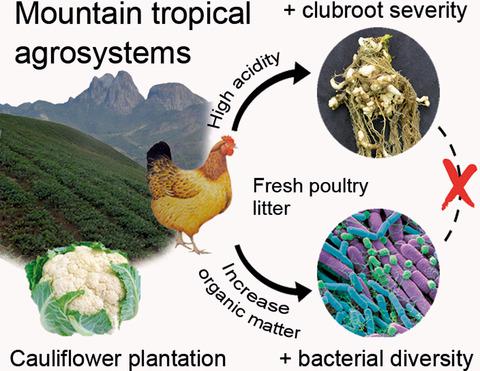当前位置:
X-MOL 学术
›
Plant Pathol.
›
论文详情
Our official English website, www.x-mol.net, welcomes your
feedback! (Note: you will need to create a separate account there.)
Soil management in a mountain agroecosystem and clubroot disease
Plant Pathology ( IF 2.3 ) Pub Date : 2019-12-11 , DOI: 10.1111/ppa.13123 A. S. Bhering 1 , M. G. F. Carmo 1 , I. S. Coelho 2 , E. S. A. Lima 3 , C. F. Carvalho 4 , A. L. R. F. Saraiva 2 , S. R. Passos 2 , N. M. B. Amaral Sobrinho 3
Plant Pathology ( IF 2.3 ) Pub Date : 2019-12-11 , DOI: 10.1111/ppa.13123 A. S. Bhering 1 , M. G. F. Carmo 1 , I. S. Coelho 2 , E. S. A. Lima 3 , C. F. Carvalho 4 , A. L. R. F. Saraiva 2 , S. R. Passos 2 , N. M. B. Amaral Sobrinho 3
Affiliation

|
Clubroot, caused by Plasmodiophora brassicae, is a disease limiting the production of Brassica species. Its severity varies according to the density of the pathogen's resting spores and environmental conditions. Although the soil environment (including its physical, chemical and biological characteristics) is determinant in the development of the disease, little is known regarding these characteristics in tropical regions, such as Brazil. The objective of this study was to investigate the relationships between soil attributes, bacterial population composition and clubroot intensity in a tropical mountain agroecosystem. Soil and plant samples were collected from 17 cauliflower‐producing localities in Nova Friburgo, Brazil. The physical and chemical attributes, the bacterial population composition, the number of pathogen resting spores in the soil samples, and the clubroot severity were evaluated. Based on bacterial population composition, two distinct groups of soils were identified, which varied in attributes such as organic matter, potential acidity, pH and disease severity. The organic matter level was associated with differences in soil acidity, bacterial population composition and disease intensity, but there was not a cause and effect relationship between bacterial population composition and clubroot severity. Under the conditions of this agroecosystem, soils with increased organic matter presented higher acidity potential (H + Al), which was strongly correlated to clubroot severity. Thus, high acidity potential could be a key factor leading to clubroot development in mountain regions of Brazil.
中文翻译:

山区农业生态系统中的土壤管理和根瘤病
由芸苔疟原虫引起的Clubroot是限制芸苔属植物产量的疾病种类。其严重程度取决于病原体静止孢子的密度和环境条件。尽管土壤环境(包括其物理,化学和生物学特性)在疾病的发展中起着决定性作用,但对于热带地区(如巴西)的这些特性知之甚少。这项研究的目的是调查热带山区农业生态系统中土壤属性,细菌种群组成和根部强度之间的关系。从巴西新星弗里堡的17个产花椰菜的地方收集了土壤和植物样本。评估了土壤样品的理化特性,细菌种群组成,病原体静止孢子的数量以及根的严重程度。根据细菌种群组成,确定了两组不同的土壤,它们的属性各不相同,例如有机物,潜在的酸度,pH和疾病的严重程度。有机质水平与土壤酸度,细菌种群组成和疾病强度的差异有关,但细菌种群组成与根部严重程度之间没有因果关系。在这种农业生态系统的条件下,有机质增加的土壤呈现出更高的酸度潜力(H + Al),这与根部的严重程度密切相关。因此,高酸度潜力可能是导致巴西山区根部生长的关键因素。pH值和疾病严重程度。有机质水平与土壤酸度,细菌种群组成和疾病强度的差异有关,但细菌种群组成与根部严重程度之间没有因果关系。在这种农业生态系统的条件下,有机质增加的土壤呈现出更高的酸度潜力(H + Al),这与根部的严重程度密切相关。因此,高酸度潜力可能是导致巴西山区根部生长的关键因素。pH值和疾病严重程度。有机质水平与土壤酸度,细菌种群组成和疾病强度的差异有关,但细菌种群组成与根部严重程度之间没有因果关系。在这种农业生态系统的条件下,有机质增加的土壤呈现出更高的酸度潜力(H + Al),这与根部的严重程度密切相关。因此,高酸度潜力可能是导致巴西山区根部生长的关键因素。有机质增加的土壤表现出较高的酸度潜力(H + Al),这与根部的严重程度密切相关。因此,高酸度潜力可能是导致巴西山区根部生长的关键因素。有机质增加的土壤表现出较高的酸度潜力(H + Al),这与根部的严重程度密切相关。因此,高酸度潜力可能是导致巴西山区根部生长的关键因素。
更新日期:2019-12-11
中文翻译:

山区农业生态系统中的土壤管理和根瘤病
由芸苔疟原虫引起的Clubroot是限制芸苔属植物产量的疾病种类。其严重程度取决于病原体静止孢子的密度和环境条件。尽管土壤环境(包括其物理,化学和生物学特性)在疾病的发展中起着决定性作用,但对于热带地区(如巴西)的这些特性知之甚少。这项研究的目的是调查热带山区农业生态系统中土壤属性,细菌种群组成和根部强度之间的关系。从巴西新星弗里堡的17个产花椰菜的地方收集了土壤和植物样本。评估了土壤样品的理化特性,细菌种群组成,病原体静止孢子的数量以及根的严重程度。根据细菌种群组成,确定了两组不同的土壤,它们的属性各不相同,例如有机物,潜在的酸度,pH和疾病的严重程度。有机质水平与土壤酸度,细菌种群组成和疾病强度的差异有关,但细菌种群组成与根部严重程度之间没有因果关系。在这种农业生态系统的条件下,有机质增加的土壤呈现出更高的酸度潜力(H + Al),这与根部的严重程度密切相关。因此,高酸度潜力可能是导致巴西山区根部生长的关键因素。pH值和疾病严重程度。有机质水平与土壤酸度,细菌种群组成和疾病强度的差异有关,但细菌种群组成与根部严重程度之间没有因果关系。在这种农业生态系统的条件下,有机质增加的土壤呈现出更高的酸度潜力(H + Al),这与根部的严重程度密切相关。因此,高酸度潜力可能是导致巴西山区根部生长的关键因素。pH值和疾病严重程度。有机质水平与土壤酸度,细菌种群组成和疾病强度的差异有关,但细菌种群组成与根部严重程度之间没有因果关系。在这种农业生态系统的条件下,有机质增加的土壤呈现出更高的酸度潜力(H + Al),这与根部的严重程度密切相关。因此,高酸度潜力可能是导致巴西山区根部生长的关键因素。有机质增加的土壤表现出较高的酸度潜力(H + Al),这与根部的严重程度密切相关。因此,高酸度潜力可能是导致巴西山区根部生长的关键因素。有机质增加的土壤表现出较高的酸度潜力(H + Al),这与根部的严重程度密切相关。因此,高酸度潜力可能是导致巴西山区根部生长的关键因素。











































 京公网安备 11010802027423号
京公网安备 11010802027423号